The Ventura County Watershed Protection District has numerous programs dealing with habitat protection & restoration following the devastating Thomas Fire that burned from Dec. of 2017 through March of 2018.
Among it’s many programs to keep debris basins clear and roads & trails accessible and safe, the Watershed Protection District was recently awarded commendations at the national & even international level, for their innovative work to replace the use of rodenticides with natural rodent control using raptors.
The following presentation (while an episode of The Coast & River Report) is actually the official presentation by the director of the Ventura County Watershed Protection District Dr. Karl Novak.
For more information about supporting and even assisting with this incredible project, please contact the VC Public Works Dept. at http://vcpublicworks.org/watershed-protection-district/watershed-protection-district
ForestWatch and Partners Win Landmark Ruling to Protect Endangered Steelhead
by ForestWatch on SEPTEMBER 27, 2022 in CUYAMA VALLEY, RIVERS, SAN LUIS OBISPO COUNTY, SANTA BARBARA COUNTY
SANTA MARIA, CA – The Ninth Circuit Court of Appeals issued an opinion Friday ruling that the operators of Twitchell Dam – the Bureau of Reclamation (“Reclamation”) and the Santa Maria Valley Water Conservation District (“the District”) – can release water from the Dam to comply with the Endangered Species Act (“ESA”). This ruling marks an important step toward protecting the endangered Southern California Steelhead in the Santa Maria River system.
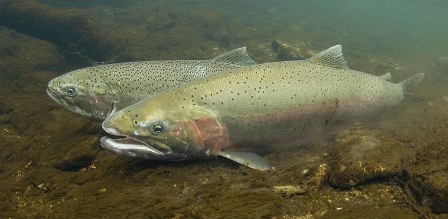
In 2019, plaintiffs San Luis Obispo Coastkeeper and Los Padres ForestWatch filed a lawsuit in federal district court, represented by the Environmental Defense Center, Sycamore Law, Inc., and Aqua Terra Aeris Law Group. The case alleges that the Dam’s operators are violating the ESA by limiting the quantity and timing of flows in the Santa Maria River to levels that harm the critically-imperiled Steelhead population. The case seeks to enhance an important stretch of the Santa Maria River to benefit the watershed, wildlife, and local communities. With adequate flows at the right times, Steelhead will be able to once again reach historic spawning grounds in the Sisquoc River, deep in the San Rafael Wilderness of Los Padres National Forest.
The Bureau and District claimed that they were prohibited from releasing water for fish based on the 1954 legislation that authorized construction of the Dam. Although the district court ruled for the Dam operators, plaintiffs appealed that ruling, and Friday’s ruling officially reversed the district court. The Ninth Circuit noted that the “current operation of Twitchell Dam harms Southern California Steelhead by impairing their ability to migrate and reproduce.” The Court went on to hold that operation of the Dam must comply with both the law authorizing the Dam and the ESA. As the Court ruled, “the Agencies have discretion to operate Twitchell Dam for other purposes besides irrigation, conservation, and flood control—including, potentially, adjusting water discharges to support the migration and reproduction of Southern California Steelhead.”
Twitchell Dam was constructed in the 1950s, and is located on the Cuyama River, the northern tributary to the Santa Maria River. The operation of Twitchell Dam limits the timing and quantity of flows in the mainstem of the Santa Maria River, preventing Steelhead from migrating to and from the ocean and upstream spawning habitat, as the following map depicts. Without adequate flows, fish are unable to complete this process and become stranded in the dry River system.
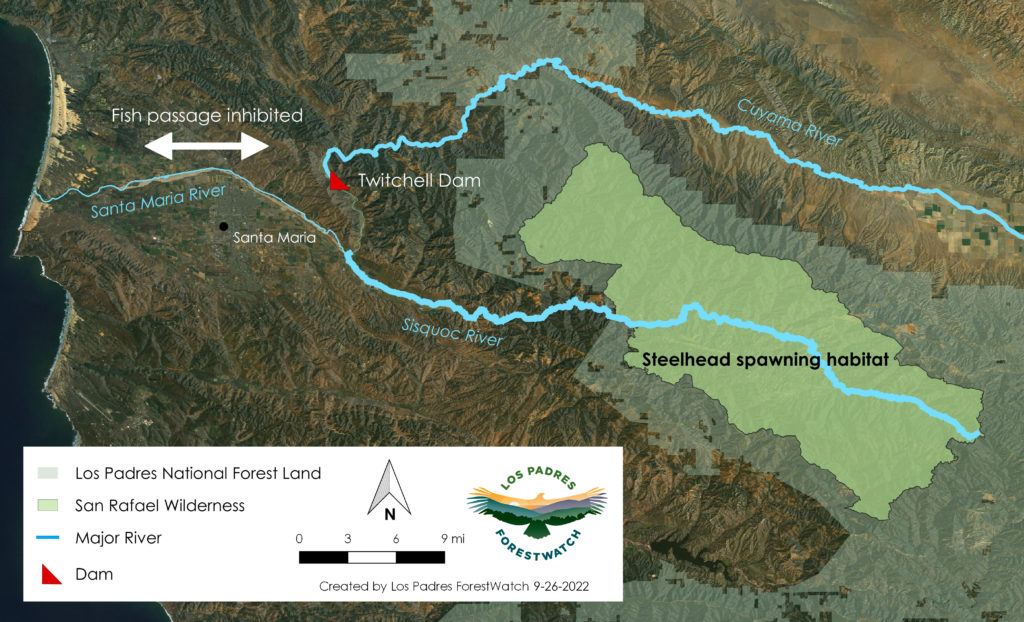
“Our lawsuit seeks to bring the Santa Maria Valley Water District out of the 1950s and into the 21st Century. Releasing water for fish migration will have virtually no impact on agricultural or domestic supply—our experts estimate 4% of reservoir water would be affected. Santa Maria can have both steelhead and its water supply with straightforward changes to water management,” said SLO Coastkeeper Executive Director Gordon Hensley.
“Endangered Steelhead have nearly disappeared from river systems throughout California’s central coast,” said Los Padres ForestWatch Executive Director Jeff Kuyper. “This landmark ruling finally gives us an opportunity to restore one of our region’s most prolific fisheries while maintaining reliable water supplies for our farms and communities.”
“This decision from the Ninth Circuit Court of Appeals is a critical first step toward recovering Steelhead—one of the most endangered fish species in the United States. The ruling puts an end to the Twitchell Dam operators’ arguments that their hands are tied and that they can avoid compliance with the Endangered Species Act,” said Linda Krop, Chief Counsel for the Environmental Defense Center, which represents Los Padres ForestWatch.

Seventy years ago, the Santa Maria River had the second largest Steelhead run in Santa Barbara County. By some estimates as many as 10,000 fish traveled up the watershed in wet years, with the Sisquoc River in the Los Padres National Forest being the most important spawning tributary within the stream network. However, several large dams have since blocked historic Steelhead runs. Now, Southern California Steelhead are one of the most endangered fish species in the United States. Steelhead are a keystone species for our region and an indicator of the health of our local waterways.
In 2007, the California Coastkeeper Alliance sued to compel the (then) California Department of Fish and Game to initiate stream flow studies as required by law. The resulting study by Stillwater Sciences recommended an improved flow regime at Twitchell Dam, yet the Water District and Reclamation refused to implement the recommendations. This lawsuit aims to implement the Stillwater Study’s recommendations to improve the flow regimes at Twitchell Dam and prevent continued harm to endangered Steelhead. The amount of water necessary to provide flows of appropriate timing and magnitude for Steelhead would constitute only roughly 4% of the reservoir’s average annual amount of stored water. No water would be released in extremely dry years.
This lawsuit complements a separate legal action filed by the two organizations in 2017. That suit, which is pending in state court, is based on longstanding California law that requires dam operators to provide adequate streamflow to sustain healthy fish populations.
The San Vicente Watershed (from the Semper Virens Fund)
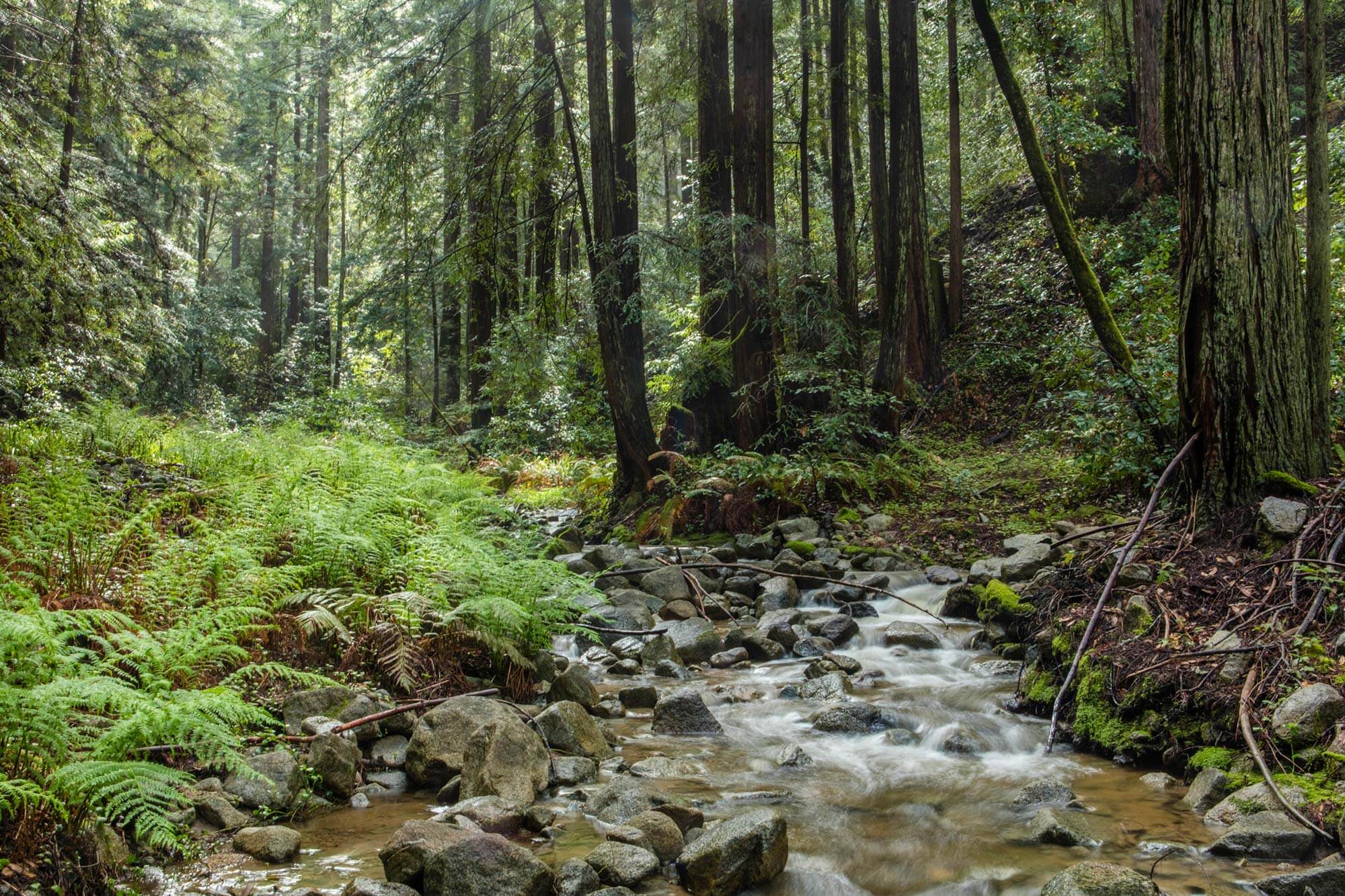
The San Vicente Creek watershed, just north of Davenport, California, is prized for its high-quality and regionally unique features. San Vicente, combined with its primary tributary, Mill Creek, is an exceptional regional creek system. Its underground karst system of limestone drainage, sinkholes, and caves feeds the creek a steady flow of water, giving the creek one of the heaviest flows in the region, even in years of drought.
And the confluence of San Vicente with the Pacific Ocean has no lagoon, making its upper reaches accessible all year around—a rare and desirable trait for fish species, such as endangered Coho salmon and threatened steelhead trout.
Over the past ten years—since Sempervirens Fund and Peninsula Open Space Trust purchased San Vicente Redwoods for permanent conservation protection, in partnership with Save the Redwoods League, and Land Trust of Santa Cruz County—restoration of this watershed has been a high priority and has been essential to restoring coast redwood, coastal prairie, and other watershed habitats.
A Dam is Born
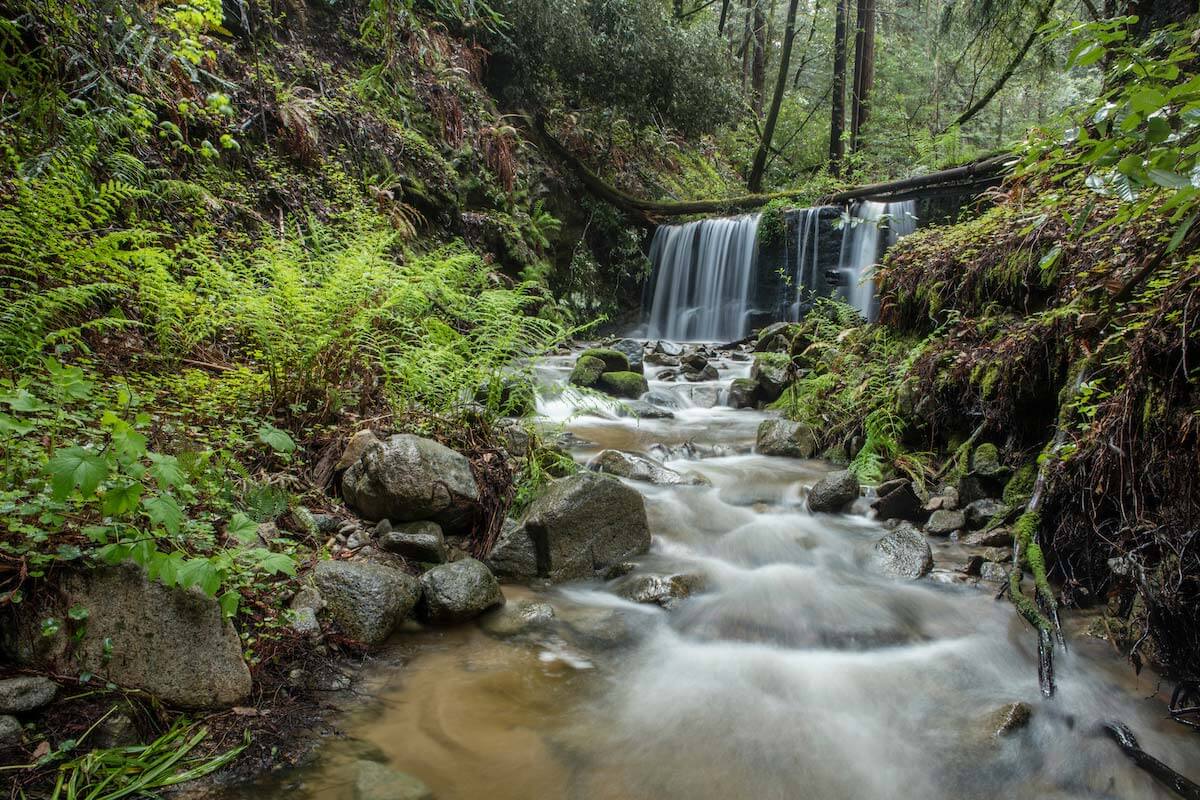
In the early 1900s, Mill Creek was dammed to support a small mining camp nestled in the Santa Cruz mountains. Poorly sited, it never worked as intended, so a new dam was installed a quarter-mile upstream, which now serves as the backup water supply for the town of Davenport.
Unfortunately, the Mill Creek dam also trapped the cobble and pebbles that feed sediment beds critical for spawning Coho salmon. Located at the Southern end of their expansive, but imperiled habitat range, Mill Creek became an ineffective spawning location and has stayed that way for more than a century.
A Silver Lining from Catastrophic Fire
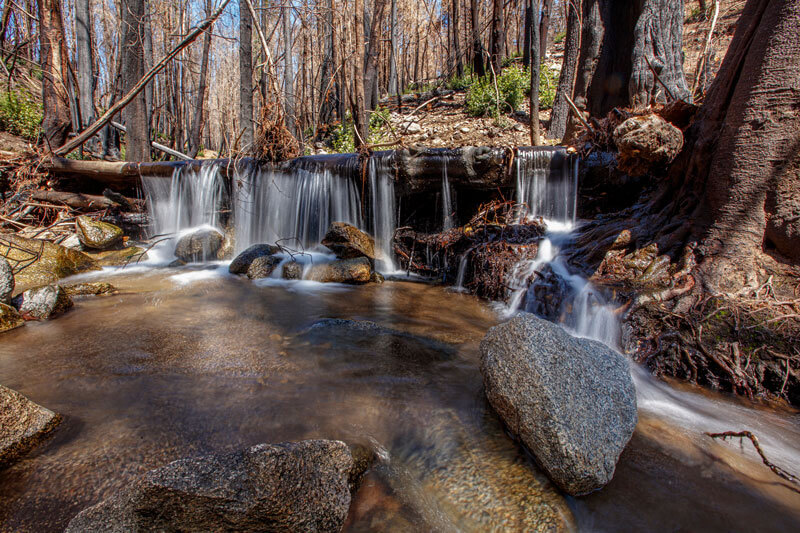
San Vicente Redwoods is an 8,532-acre stretch of the largest privately held redwood forest in the Santa Cruz mountains. The CZU Lightning Complex wildfires in August and September 2020 scorched more than 86,500 acres, including all of San Vicente Redwoods’ lands. Water lines for Davenport, which ran across the top of Mill Creek dam, were destroyed. CEMEX, the former owner of the property, funded the re-routing and replacement of their water lines in early 2021 and agreed to let Sempervirens Fund remove the old, defunct dam.
In late March 2021, Sempervirens Fund received a $550,000 grant made through the Open Rivers Fund, a program of Resources Legacy Fund supported by The William and Flora Hewlett Foundation. The grant will be further leveraged by support from individual donors for the ongoing restoration work at San Vicente Redwoods.
By October 2021, the dam was removed, and water and sediment flow were restored.
NEWS: CEMEX Agrees to Removal of Dam at Mill Creek in Santa Cruz Mountains
April 28, 2021
Sempervirens Fund secures post-fire funds to restore creek and improve Coho salmon habitat, part of long-term restoration of previously logged redwood forest
Contact: Matthew Shaffer, Sempervirens Fund, 415.609.2750, mshaffer@sempervirens.org
Download a PDF of this press release.
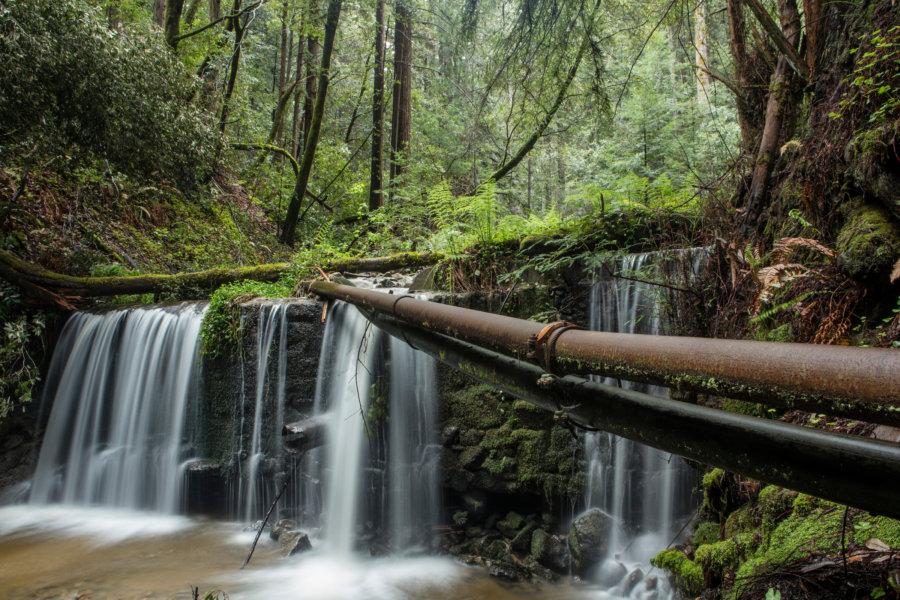
The CEMEX dam obstructs Mill Creek in San Vicente Redwoods, preventing ideal conditions for endangered Coho salmon habitat. Photo: Ian Bornarth
Los Altos, Calif. (April 28, 2021) — Sempervirens Fund announced today that they have secured approvals and critical post-fire funding to remove a dam from Mill Creek. CEMEX, the former owner of what is now San Vicente Redwoods, retains water and infrastructure rights on the property, and approved the dam removal. Deconstruction will begin later this summer.
“The dam has impeded Coho salmon from reaching desperately needed spawning habitat for decades,” said Sara Barth, Sempervirens Fund’s executive director. “Removing the dam will restore not only the creek flow, but improve sediment conditions critical for spawning. A restored creek is also essential to the health and resilience of the surrounding redwoods and other nearby and downstream habitats at San Vicente.”
San Vicente Redwoods is an 8,532-acre stretch of forest that is currently owned and managed by four conservation organizations: Sempervirens Fund, Peninsula Open Space Trust, Save the Redwoods League, and Land Trust of Santa Cruz County. Near Davenport, it is the largest privately held redwood forest in the Santa Cruz mountains. The CZU Lightning Complex wildfires in August and September 2020 scorched more than 86,000 acres, including all of San Vicente Redwoods lands. Water lines for Davenport, which ran across the top of the dam, were destroyed. CEMEX funded the re-routing and replacement of their water lines earlier this year and agreed to remove the dam. In late March Sempervirens Fund received a $550,000 grant made through the Open Rivers Fund, a program of Resources Legacy Fund supported by The William and Flora Hewlett Foundation. The grant will be further leveraged by support from individual donors for the ongoing restoration work at San Vicente. Funding for the project also came from the National Fish and Wildlife Foundation and the California Department of Fish and Wildlife, Office of Spill Prevention and Response.
“We’re thrilled to see such great teamwork,” said Julie Turrini of Resources Legacy Fund. “Sempervirens Fund efficiently coordinated the work of several government agencies, multiple conservation groups, and a partnering Tribal land trust to get this done quite rapidly—all in the wake of a devastating fire that laid bare the urgency of this project.”
Since 2011, the organizations have partnered to steward the property’s old-growth redwoods and eight creeks, home to many regionally important species of wildlife and plants, including the endangered Coho salmon. Habitat for salmon is scarce and impediments like dams diminish their access to critical waters and the gravelly sediment that makes for ideal spawning grounds. While rare in the Santa Cruz mountains, dams like the one on Mill Creek were built early last century to support redwood logging. Their utility has long since expired, and removal is the best option for repairing the ecosystem. San Vicente’s partners also collaborate with regional conservation teams, such as Resources Conservation District Santa Cruz County, to implement large-scale restoration efforts.
“The RCDSCC is proud to partner with Sempervirens Fund and other local north coast partners to advance the removal of the lower Mill Creek dam,” said Lisa Lurie, Executive Director, Resource Conservation District of Santa Cruz County. “This project, identified as a priority action for recovery of salmonids in the San Vicente Watershed, is an important step forward in helping threatened and endangered Steelhead and Coho salmon along the Central Coast of California.”
Sempervirens Fund and its partners are pursuing research projects to monitor and survey fish populations in Mill Creek and in the greater San Vicente watershed, including Coho salmon, steelhead trout, and lamprey eels, including the use of environmental DNA techniques. Past restoration projects along Mill Creek, including the introduction of large woody debris, have already reinvigorated steelhead populations, which are present this season.
Re-routing the waterlines to Davenport earlier this year and the removal of the CEMEX dam are important to regional waterway vitality and water quality.
“Mill Creek is part of a critical watershed on the North Coast which provides drinking water for the town of Davenport and habitat for Coho,” said Santa Cruz County Supervisor Ryan Coonerty. “The Mill Creek dam removal project is truly a win-win project as it will improve water quality both for the residents and the Coho.
Removing a Dam and Restoring a Watershed
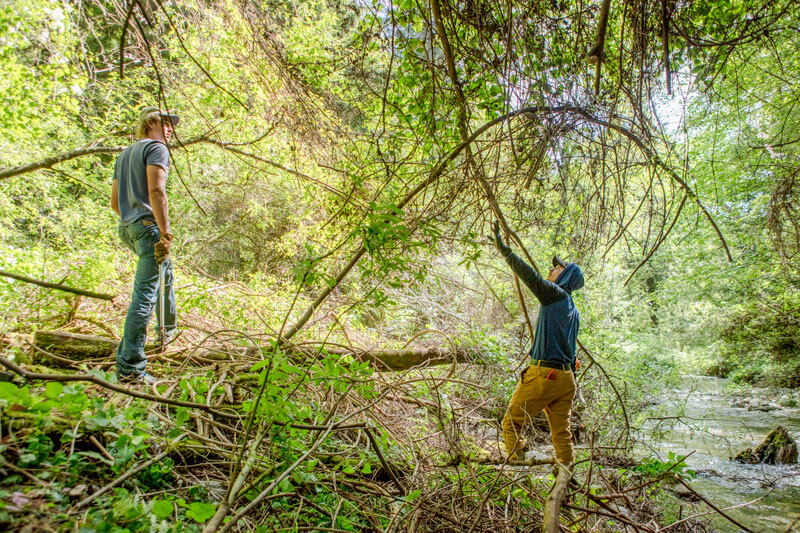
Among many important outcomes, removing the dam releases the trapped sediment that will improve the spawning conditions not just in Mill Creek, but throughout the creek system.
Thirteen large wood structures, known as “large woody debris,” installed in and among the creek beds at key locations will generate sandbars with the released cobble, giving salmonids ample spawning habitat for the first time in a century. The watershed includes floodplains which have been carefully rid of invasive clematis—a plant that can quickly choke redwoods and streams.
Together, the ecosystem will thrive, benefiting from the increased flow of creek water from above (and below), improving watershed health.
Understanding Habitat Health
From topographical surveys of the creek channel, to environmental DNA (eDNA) monitoring, to cultural and archaeological exploration throughout the San Vicente watershed, these research efforts will help ensure that restoration efforts have the desired outcomes and inform us about adjustments needed to advance the health of the ecosystem.
Removing the Mill Creek Dam, and restoring this watershed, will have benefits that will outlast us all, and bring ecological prosperity to future generations of species and the habitats they call home.